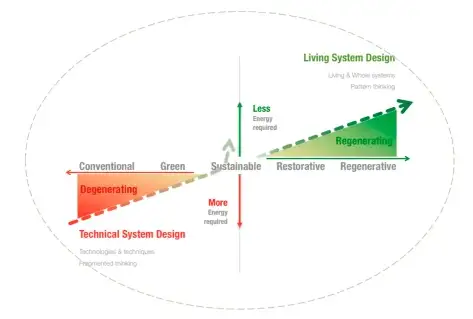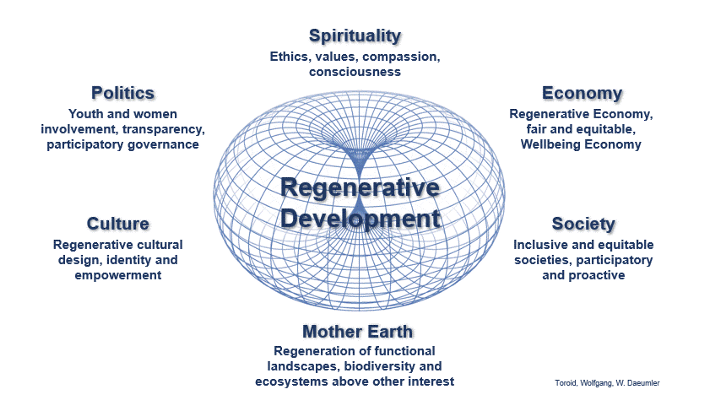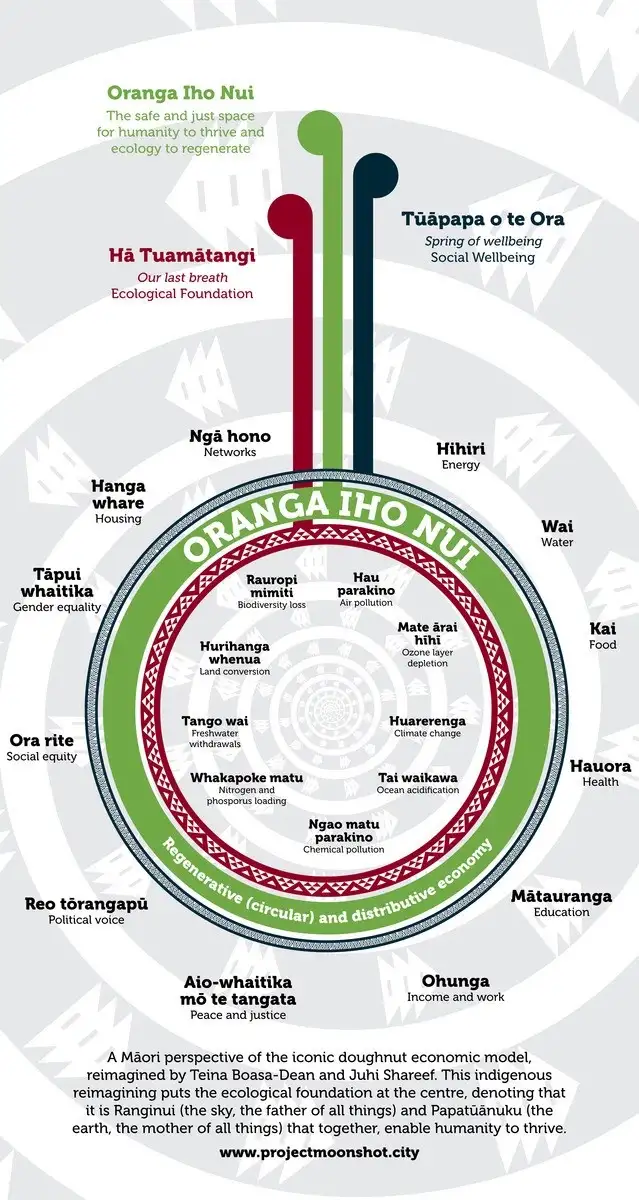Sustainability vs. regenerative explained by 5 graphics


· 7 min read
The growing awareness of environmental destruction and social inequity brought about the concept of sustainable development in the 1980s, integrating environmental and socio-economic questions. In conversations about how human development can harmoniously co-exist with the rest of the beings on our planet, we often come across the words ‘sustainability’ and ‘regeneration’. While ‘sustainability’ has been floating around in mainstream environmentalist dialogues since the 1980s, ‘regeneration’ has been around for much, much longer, ingrained in traditional and indigenous world-views, cosmovisions, and economics. Let’s dive into the differences with these well thought-out graphics.

Mainstream economics inextricably ties the height of human well-being with endless economic growth. The belief that increasing production would somehow lift people out of poverty. The Brundtland Report defines sustainable development as meeting ‘the needs of the present without compromising the ability of future generations to meet their needs’ (WCED, 1987, p. 43). Human’s needs. Inevitably, ‘sustainable development is an unashamedly anthropocentric concept’ (Lee, 2000, p. 32).
In the graph above, we see different concepts, ideologies, institutions, movements, and organisations mapped onto the spectrums of equality and ecological centredness. Natural resources management, for example, is technologically centred yet doesn’t quite promote socio-economic equality. Certainly, many natural resource management initiatives don’t take into account the people and communities who depend their livelihoods on that resource. Indeed, viewing the gifts of nature as ‘natural resources’ in itself is undeniably anthropocentric. What’s interesting in this graph is the highlight of Ecofeminists, Ecosocialists, and Indigenous/ ‘South’ movements as movements that are high in socio-economic well-being and equality, as well as ecological centredness. We get a sense of what and where we should be striving towards.

Regenerative design (the far right side of the graph in green) seeks to redefine sustainability (centre of the graph). Here, sustainability is shown as simply staying where we are, minimising the negative without contributing to the positive. Net zero.
Instead, regenerative designs actively rebuilds, restores, and well, regenerates the health, spirit, culture, and place of all beings. Environmental issues need to be observed, understood, and solved in an approach that is holistic, deeply integrated, comprehensive, and whole-systems. There is an understanding that humans are a part of nature, not apart from, and that we have a positive role to play. Developing mutualism, co-evolutionary, and a conscious, intentional inter-relationship with the whole ecology. Deeply understanding that human health is planet health, and vice versa.
Of course, this is much easier said than done. After all, there is no silver bullet or a ‘menu approach’ to implementing regenerative approaches — it requires a deep understanding of place and context of all the living beings involved. Reconciling these two radically different, maybe even polarised, world-views that shape technological approaches and ecological regeneration is challenging.
As M. Kat Anderson eloquently puts it in ‘Tending the Wild’: ‘Wilderness is a negative label for land that has not been taken care of by humans for a long time… California Indians believe that when humans are gone from an area long enough, they lose the practical knowledge about correct interaction, and the plants and animals retreat spiritually from the earth or hide from humans. When intimate interaction ceases, the continuity of knowledge passed down through generations, is broken, and the land becomes “wilderness”.’

This chart shows the evolution of regenerative concept in the western world. On one end, in mechanistic, reductionist thinking, ‘compliance’ can be interpreted as meeting minimum standards of current regulations and laws, or perhaps Environmental, Social, and Governance (ESG) criteria. On the other end, using living and whole systems thinking, regeneration creates new life, builds new capacities, grows back stronger. The question is how do we move our whole system (economic, social, political, spiritual, environmental, health, educational, etc, etc, etc) towards regeneration?

Dr Eduard Müller’s model of regenerative development encapsulates 6 areas — Mother Earth, culture, politics, spirituality, economy, and society, with Mother Earth at the base, signifying her important role in supporting all of our lives and necessities. In this view, all 6 processes are closely interlinked and supported by one another, creating new inter-related paradigms, structures, and values. For example, land degradation in one territory might be affecting the local production and economy, reducing social resilience, which in turn leads to a lack of governance, inequity, and crime. Unless we treat this issue in an inter-disciplinary way and work with the communities involved, it would be difficult to come up with a long-lasting solution that regenerates the land and the communities around.
Reimagining whole systems with these 6 areas or layers would require some degree of ‘unlearning’ of conventional reductionist concepts and approaches, as well as cross- and inter-disciplinary ideation and co-operation. Perhaps we need to do away with the ever specialisation process in our current education system that often limit perspectives and possibilities.

Doughnut economics is a ‘playfully serious approach to framing the challenge’ of meeting life’s essentials within social and planetary boundaries and ‘acts as a compass for human progress this century’ (Raworth). As of 2017, humanity as a whole has been seeing a severe shortfall in all social dimensions, including access to healthy food, clean water, social equity, gender equality, and more, while overshooting on 4 out of 9 planetary boundaries (defined by Rockstrom et al.), namely climate change, huge biodiversity loss, loss of forested land, and nitrogen and phosphorus loading. Clearly, sustaining the current situation would be less than ideal, socio-environmental restoration is the minimum requirement, and active regenerative transformation has to take place for all lives to thrive.
Teina Boasa-Dean and Juhi Shareef’s reimagination of the doughnut from a Māori perspective offers insights into indigenous world-views, by putting Earth’s needs in the centre instead of that of humans. Boasa-Dean and Shareef also renames ‘planetary boundaries’, or ‘ecological ceiling’, to hā tuamātangi, or ‘the Earth’s last breath’, making us pause and appreciate Mother Earth’s life-giving and life-sustaining generosity. This doughnut depiction is the perspective of one Māori person, so it doesn’t represent the view of all Māori people.
Hear Teina Boasa-Dean explain her depiction of the doughnut in the podcast, Moonshot:City.

Kamaljit Kaur Sangha (2015) proposes a model of integrated indigenous economy and ecosystems. As seen in the graph, each component of human society relates and connects in a bi-directional way with the surrounding ecosystems. In a capitalistic society, the ‘economic world’ would be all encompassing, with the social and cultural world feeding and depleting into it, and ecosystems being actively drained, extracted from, and destroyed. This graph offers yet another indigenous view that embeds human beings and doings in the larger ecosystems, conscious that every action affects the world around us. For example, we work the land, the land feeds us, and so we have the responsibility to take care of the land and all that depend on the land.
Our health and the ecosystems’ health cannot be separated from one another. Understanding and appreciating that natural systems are directly connected to humanity’s actions help us rethink our values, priorities, and capabilities, as well as better inform political and business decision making
Future Thought Leaders is a democratic space presenting the thoughts and opinions of rising Energy & Sustainability writers, their opinions do not necessarily represent those of illuminem. This article has also been published by Trueque Intercambios.
illuminem briefings

Sport · Social Responsibility
illuminem briefings

AI · Green Tech
illuminem briefings

Sustainable Lifestyle · Social Responsibility
Deutsche Welle

AI · Green Tech
The Independent

Effects · Climate Change
The Globalist

Climate Change · Effects